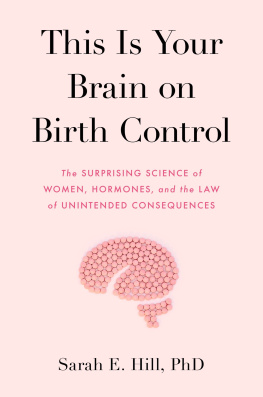THE BIRTH
of
THE PILL
How Four Crusaders
Reinvented Sex and Launched
a Revolution
JONATHAN EIG

W. W. NORTON & COMPANY NEW YORK | LONDON
For Jennifer
Sexual intercourse began
In nineteen sixty-three
(which was rather late for me)
Between the end of the Chatterley ban
And the Beatles first LP.
PHILIP LARKIN, ANNUS MIRABILIS
Contents
THE BIRTH of THE PILL
Manhattan,
She was an old woman who loved sex and she had spent forty years seeking a way to make it better. Though her red hair had gone gray and her heart was failing, she had not given up. Her desire, she said, was as strong and simple as ever: She wanted a scientific method of birth control, something magical that would permit a woman to have sex as often as she liked without becoming pregnant. It struck her as a reasonable wish, yet through the years one scientist after another had told her no, it couldnt be done. Now her time was running out, which was why she had come to an apartment high above Park Avenue to meet a man who was possibly her last hope.
The woman was Margaret Sanger, one of the legendary crusaders of the twentieth century. The man was Gregory Goodwin Pincus, a scientist with a genius IQ and a dubious reputation.
Pincus was forty-seven years old, five feet ten and a half inches tall, with a bristly mustache and graying hair that shot from his head in every direction. He looked like a cross between Albert Einstein and Groucho Marx. He would speed into a room, working a Viceroy between his yellowed fingers, and people would huddle close to hear what he had to say. He wasnt famous. He owned no scientific prizes. No world-changing inventions were filed under his name. In fact, for a long stretch of his career he had been an outcast from the scientific establishment, rejected as a radical by Harvard, humiliated in the press, and left with no choice but to conduct his varied and oftentimes controversial experiments in a converted garage. Yet he radiated confidence as if he knew the world would one day recognize his brilliance.
Pincus was a biologist and perhaps the worlds leading expert in mammalian reproduction. In the 1930s, at the start of his professional career, hed attempted to breed rabbits in Petri dishes using much the same technology that decades later would lead to in vitro fertilization for humans. Then he was young and handsome and possessed of a limitless imagination. He posed for newspaper photographs and boasted to reporters that a new age of human reproduction was on the horizon, one in which men and women soon would employ modern methods to control the process of making babies. Science would lead the way.
But Americans were not ready to hear such things. The press compared him to Victor Frankenstein, Mary Shelleys fictional scientist, who tried to conjure life but accidentally created a monster. Harvard denied Pincus tenure, and no other university would hire him. He was deemed too dangerous.
At that point, a more humble man might have chosen a new line of work. A weaker man might have succumbed to anger or despair. But not Goody, as his friends and family called him, as much for his friendly nature as his middle name. For while Pincus was affectionate and disarming in social settings, when it came to his career he was, as one colleague put it, .
Again, he might have quit. Instead, Pincus and one of his colleagues, Hudson Hoagland, did something unprecedented: they launched their own scientific research center. They went door to door in Worcester (pronounced wuhstah, in the local tongue) and the surrounding area, distributing brochures and asking housewives, plumbers, and hardware store owners to contributeno donation too smallto a new institution they called the Worcester Foundation for Experimental Biology. With the money they scraped together, they bought an old house in nearby Shrewsbury, where Pincus set up his office and lab in the garage. The operation was so lean in those early years that he cleaned his own animal cages and, at one even lower moment, moved his wife and children into a state-run insane asylum while conducting research there on schizophrenia.

Pincus knew about Sanger. Almost everyone in America did. It was Sanger who had popularized the term birth control and almost single-handedly launched the movement for contraceptive rights in the United States. Women would never gain equality, she had argued, until they were freed from sexual servitude. Sanger had opened the nations first birth control clinic in Brooklyn in 1916 and helped launch dozens more around the world. But even after decades of work, the contraceptive devices available at those clinicscondoms and cervical caps, mostlyremained ineffective, impractical, or difficult to obtain. It was as if shed been teaching starving people about nutrition without giving them anything healthy to eat. Sanger explained to Pincus that she was looking for an inexpensive, easy-to-use, and completely foolproof method of contraception, preferably a pill. It should be something biological, she said, something a woman could swallow every morning with her orange juice or while brushing her teeth, with or without the consent of the man with whom she was sleeping; something that would make sexual intercourse spontaneous, with no forethought or messy fumbling, no sacrifice of pleasure; something that would not affect a womans fertility if she wished to have children later in life; something that would work everywhere from the slums of New York to the jungles of southeast Asia; something 100 percent effective.
Could it be done?
The other scientists shed approached, every one of them, had said no, and they had given her a long list of reasons. It was dirty, disreputable work. The technology wasnt there. And even if it somehow could be done, there would be no point. Thirty states and the federal government still had anti-birth-control laws on the books. Why go to the trouble of making a pill no drug company would dare to manufacture and no doctor would dare prescribe?
But Sanger held out hope that Gregory Pincus was different, that he might be bold enoughor desperate enoughto try.

It was the midpoint of the century. Scientists were taking up matters of life and death that once had been the domain principally of artists and philosophers. Men in lab coatsand yes, they were almost all menwere heroes, winners of wars, battlers of disease, givers of life. Malaria, tuberculosis, and syphilis were among the many illnesses surrendering to modern medicine. Governments and giant corporations poured unprecedented sums of money into research, sponsoring everything from high school science clubs to cold fusion exploration. Health became a political issue as well as a social one. World War II had scarred the earth but also transformed it, offering the promise of a better, freer world, and scientists were leading the way.
Americans were settling into new suburban box homes and exploring the joys of lawn care, dry martinis, and I Love Lucy. At least to the casual observer, the United States in the early 1950s appeared staid and steadfast. The Andrews Sisters sang I Wanna Be Loved and John Wayne starred in Sands of Iwo Jima, celebrating the nations military might and commitment to democratic ideals.
It was a glorious time to be an American. Young men returning from battle were looking for new adventures and new ways to feel like heroes as they adjusted to the dullness of their homes, marriages, and jobs. During the war, new rules of morality had applied. Sex had become a more casual endeavor as foreign women traded their bodies to American soldiers for cigarettes and cash. Girlfriends back home had written steamy letters filled with promises of the great passion awaiting their men. In truth, many of the women back home had been exploring their own new moral standards. The war had thrust women into the workplace, putting money in their pockets and liberating them from their parental homes. Theyd begun dating and making love to men they did not intend to marry, experimenting with new ideas about intimacy and commitment. In 1948, a college professor in Indiana named Alfred Charles Kinsey published a study called
Next page









